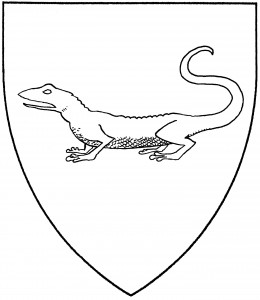The lizard is a small, agile reptile with a reputation for speed. It’s a period charge, found in the crest of the Worshipful Company of Ironmongers, 1455 [Bromley & Child 148], and in the canting arms (Portuguese lagarto) of Lagartos, c.1540 [Nobreza xxxviiº].
The lizard is statant by default, as in the illustration. In Society armory, however, it’s frequently found tergiant. It is also sometimes blazoned as a “natural salamander”, since it forms the basis of the usual depiction of the salamander. The lizard’s cousin, the “newt” or “aske”, was used as the badge of Christopher Aske, 1536 [Siddons II.2 16].
Similar footed reptiles, such as the “chameleon”, have also been employed in Society armory. Also included in this category are what may be termed the giant lizards: the “crocodile”, the “alligator”, and the “Komodo dragon”. These are still permitted as of this writing, but those from outside the scope of period Europe (e.g., the alligator) are deemed a step from period practice.
Emmanuelle de Chenonceaux bears: Ermine, a lizard tergiant azure.
Vespacia Capricornica Kareliae bears: Pily bendy Or and vert, a natural chameleon gules.
Fiona di Varanus bears: Gules, a pale cotised Or, overall a Komodo dragon embowed in pale vert.
